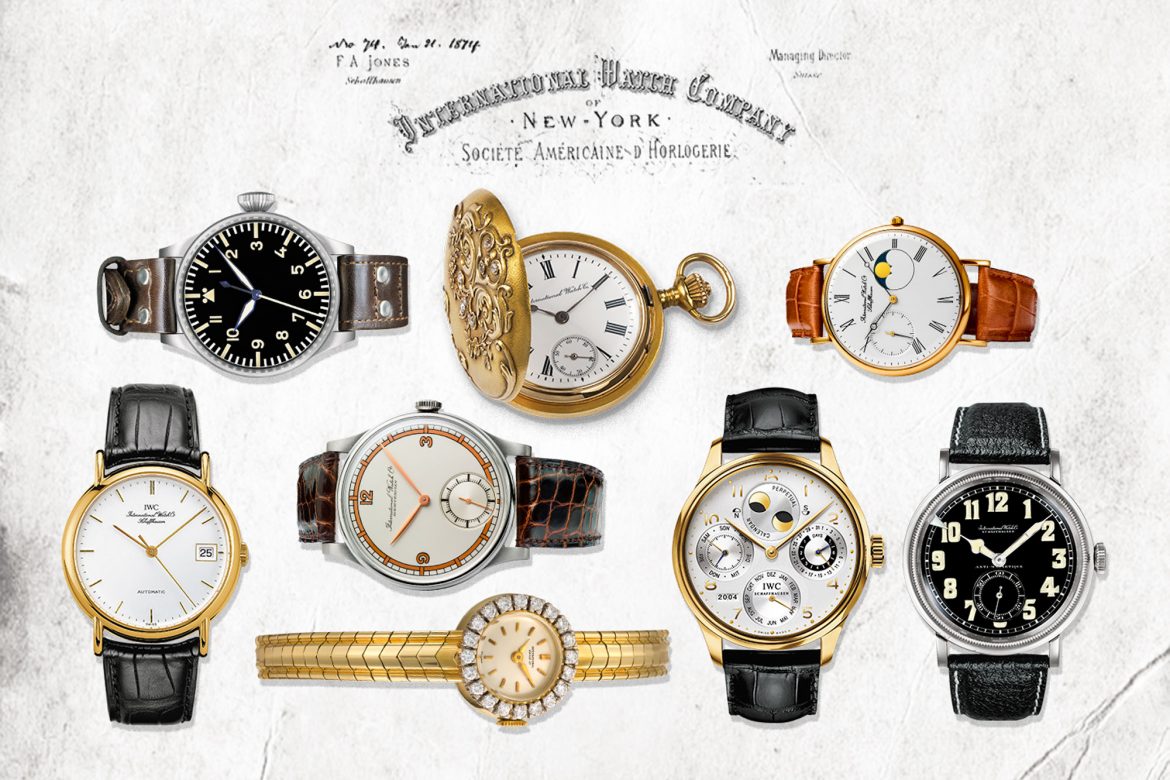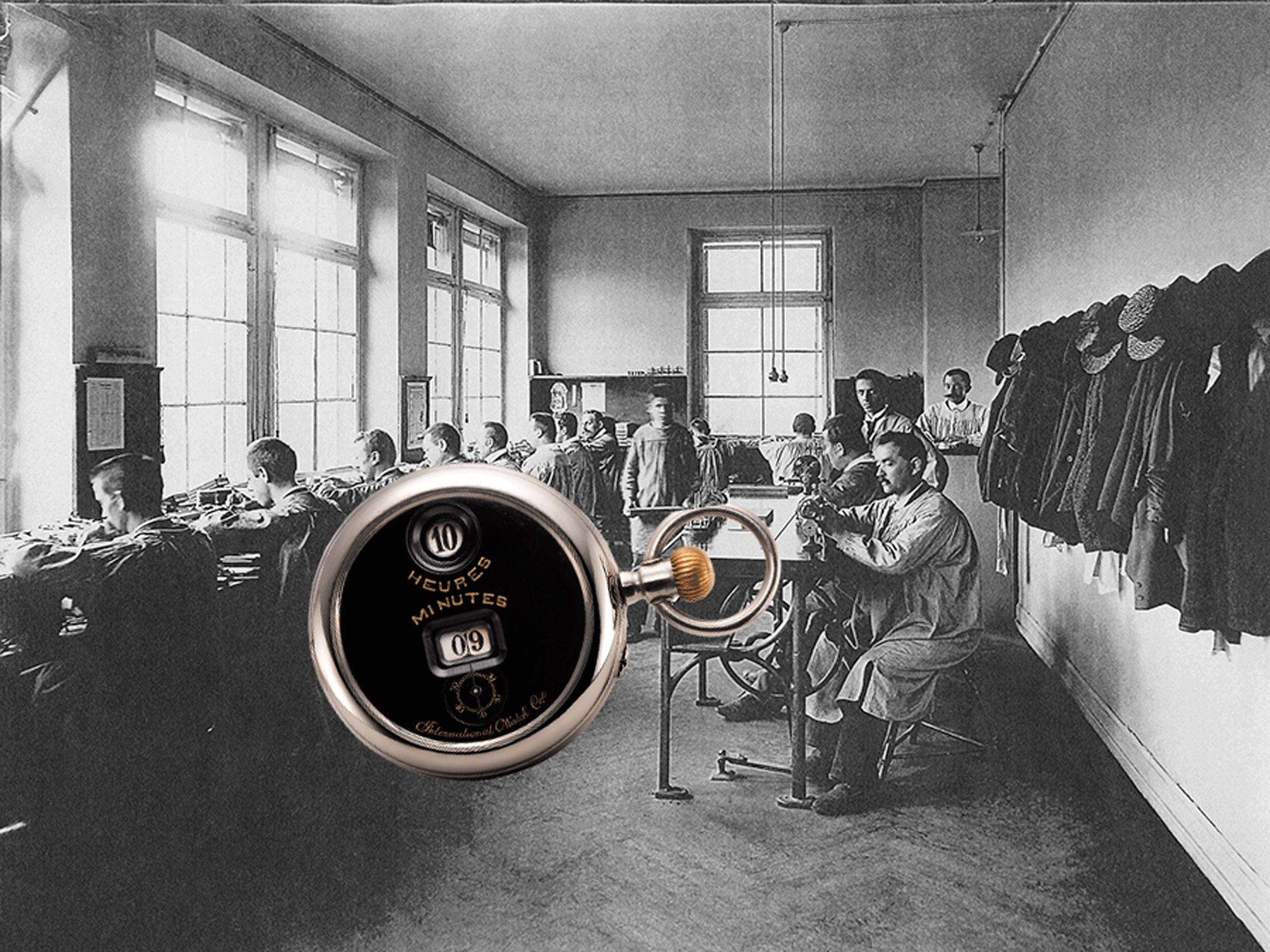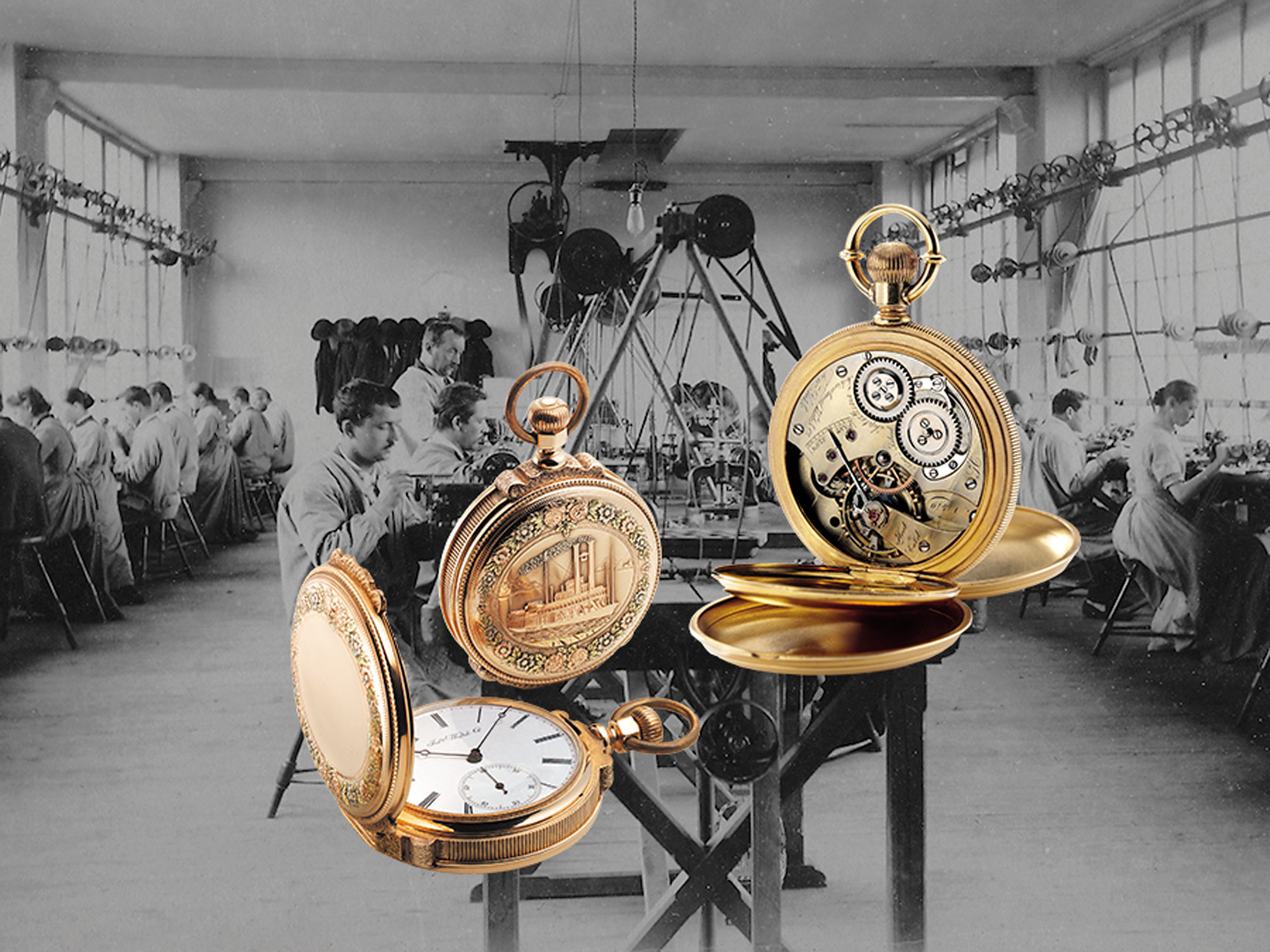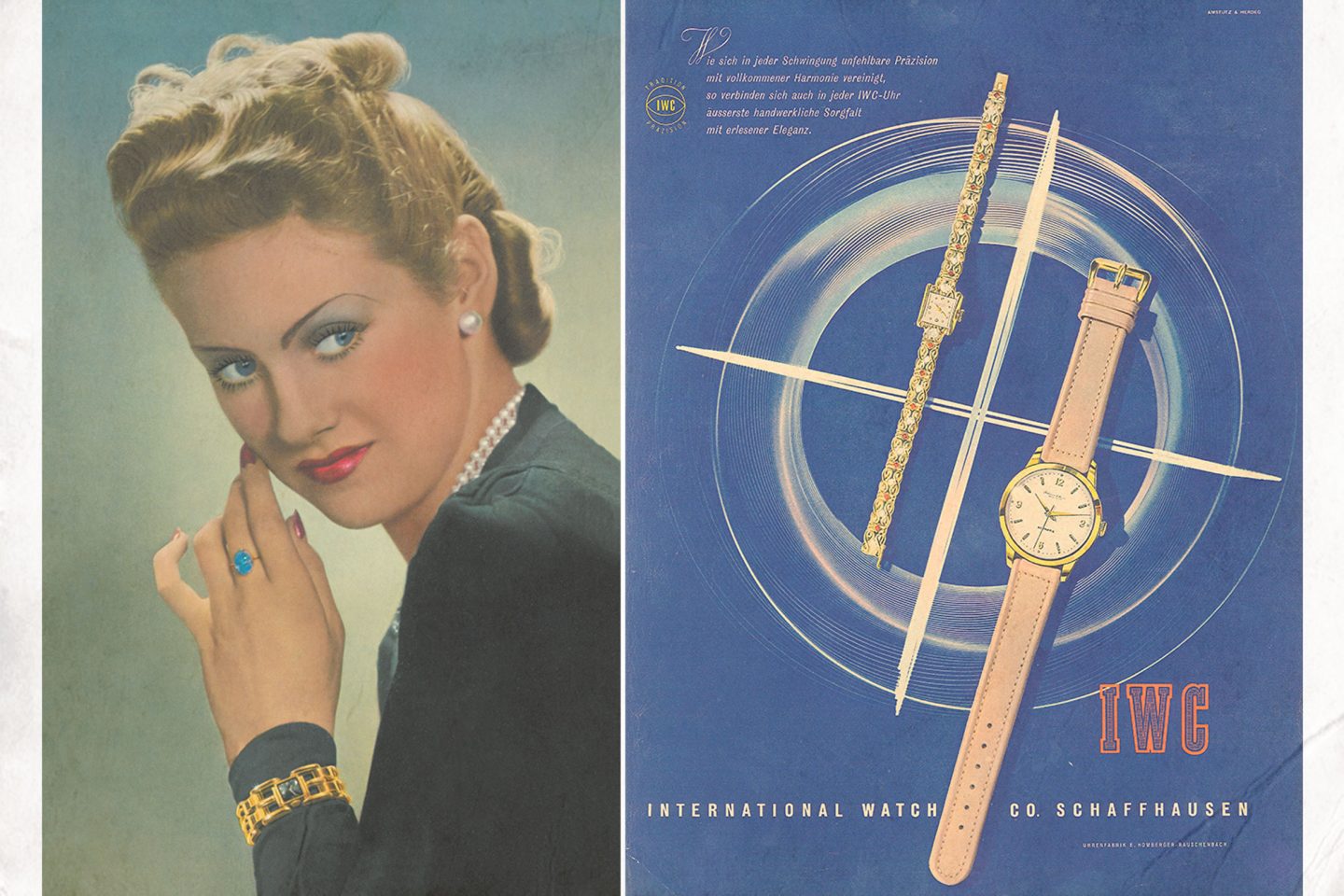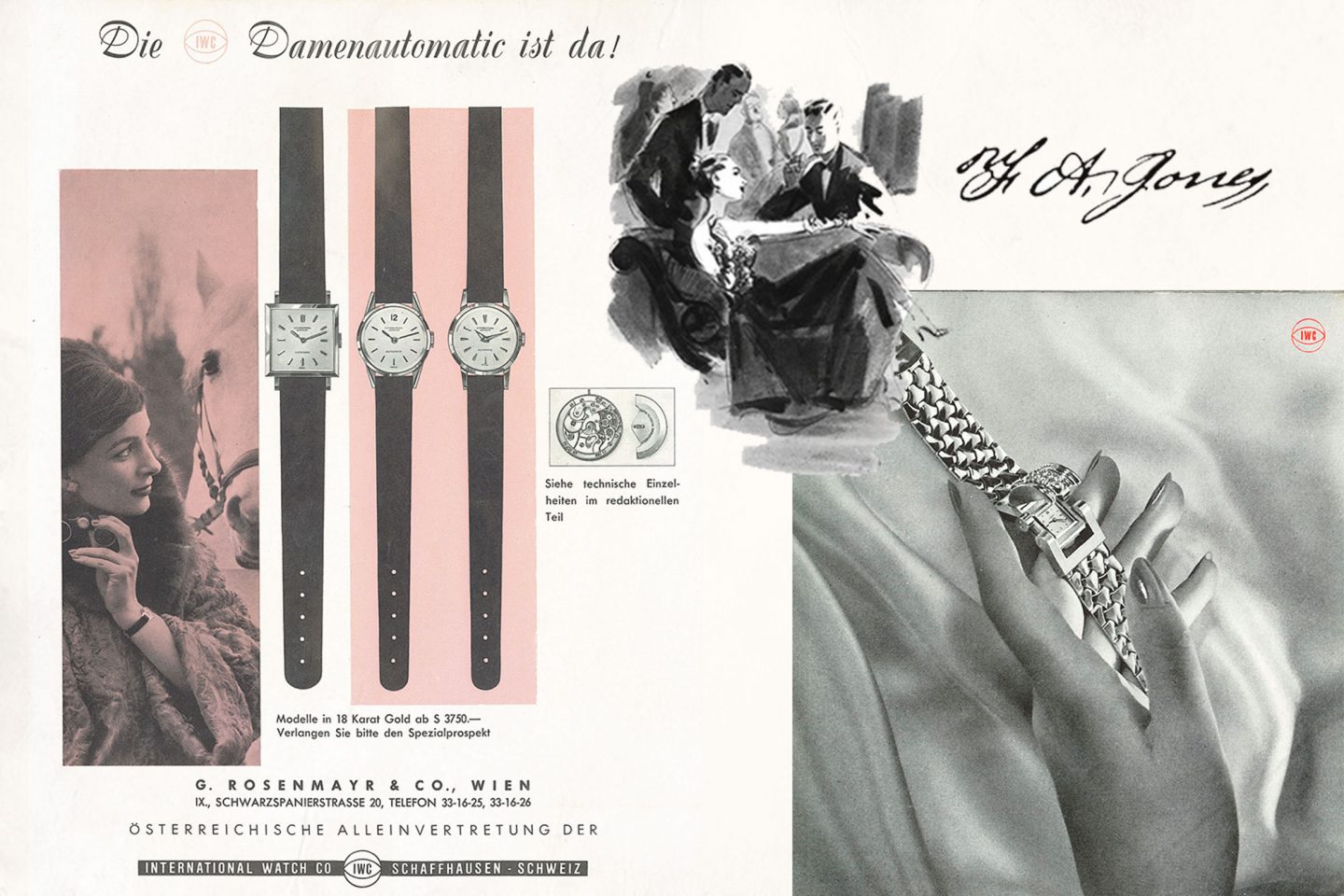In conjunction with a new exhibition tracing IWC’s design evolution over the past 151 years, we highlight some of the Swiss watchmaker’s most iconic watch families and standout models.
It was the spirit of endeavour and a bold entrepreneurial idea that started the International Watch Company – or IWC, as we know it.
In 1868, American watchmaker Florentine Ariosto Jones founded the company in Schaffhausen in Northern Switzerland, with the vision of creating top-quality Swiss-made pocket watch movements for the American market.
The first Jones calibre pocket watches were produced around 1870, and was notable for its particular construction using three-quarter plates, which gave them greater stability and simplified the production of small parts – making them widely adopted in the US.
This was shortly followed by IWC’s contribution to the digital era with its first ever pocket watch to feature jumping numerals, showing hours and minutes in large numerals on rotating discs. Launched in 1884, the Pallweber pocket watch preceded the advent of of quartz watches by more than a century.
Since then, the IWC has continued to enjoy an esteemed lineage of technical innovators at its helm and as part of its team of master watchmakers, such as Albert Pellaton who developed the hand wound 89 calibre in 1946, and Kurt Klaus who is famous for contributing the moon phase display and perpetual calendar in the 70s.
With a clear focus on technology and development, IWC gained an international reputation for producing desirable timepieces of lasting value. Over 151 years, IWC established itself as not only one of the very best luxury watchmakers in the world, but also one of its most progressive pioneers.
In its broadest retrospective exhibition in Southeast Asia yet, IWC will be unveiling a new showcase in Singapore featuring 20 references from its most iconic watch lines – Pilot’s Watches, Portugieser and Portofino, as well as some rare ladies’ timepieces.
“The beauty of IWC is in the unique spirit of its watch families. For instance, our Pilot’s Watches bring to life the dream of flying; the Portugieser carries our most sophisticated complications; and the Portofino captures the classic elegance that we, as a luxury brand, do exceedingly well,” says Mr. Stanislas Rambaud, Managing Director for IWC South East Asia.
“We are proud to debut in Singapore this first-of-its-kind exhibition concept, which allows our most valued clients, fans of IWC and the public to immerse themselves in the emotions of our most successful lines at the same time.”
Here are some standout watch families and models that have contributed significantly throughout the evolution of IWC.
Pilot’s Watches
In the 1930s, progress made at air and sea had created a growing need for timepieces that offered maximum reliability under the toughest conditions. Inspired by his aviation-enthusiast sons, Ernst Jakob Homberger, who took over the helm of IWC in 1905, launched the Special Pilot’s Watch in 1936, establishing one of the watchmaker’s most iconic watch families, and a tradition that has been maintained to this day.
- 436, Special Pilot’s Watch, 1936
In the pioneering age of flying, most pilots were still using pocket watches – a wristwatch developed specially for pilots was a real innovation. Designed for use in the cockpit, the timepiece is driven by the 83 calibre with an antimagnetic escapement. The watch functions reliably at temperatures between -40 and +40 degrees Celsius, and features shatterproof glass and a rotating bezel to set flight times. The black dial with high-contrast luminescent hands and numerals made for quick and easy reading in poor visibility, and has remained a central design feature of Pilot’s Watches from Schaffhausen to this very day.
- 431, Big Pilot’s Watch, 1940
The Big Pilot’s Watch was first manufactured and supplied to the German Air Force in 1940 in an edition of 1,000 pieces. Constructed according to the German Air Force’s specifications for observation watches, this is the largest wristwatch ever built by IWC, with a case diameter of 55mm, a height of 16.5mm and a weight of 183g. It was powered by the Calibre 52 T.S.C. In 2002, with the Ref. 5002, IWC revived the tradition of the Big Pilot’s Watch. The Big Pilot became an icon with many varieties later launched.
Portugieser
In the late 1930s, IWC tried to further develop its business in various markets. In 1939, two Portuguese business put in an order for “a seriously big wristwatch” that could run as precisely as a marine chronometer for captains and officers of the Portuguese merchant navy – and IWC did just that.
- 325, Portugieser Hand Wound, 1942
The first Portugieser, Reference IW325, had a case diameter of 41.5mm and far exceeded the dimensions of conventional wristwatches of the era. Schaffhausen’s design engineers had decided to put the men’s pocket watch 74 calibre into a wristwatch case. Initially, that watch had neither a name nor a reference number – it later became noted as “Reference 325”. It was this number that designated the model of the original “Portuguese” wristwatch, even though it was never shown in any IWC catalog.
- 5021, Portugieser Perpetual Calendar, 2003
In the 1970s, at the beginning of the Quartz Crisis, there was a radical change in strategy at IWC. Against the general trend towards quartz watches, it decided to concentrate on the production of high-value complicated pocket watches for the collectors’ market. Master watchmakers in Schaffhausen, such as Kurt Klaus, designed exclusive complicated movements for the few remaining collectors of top-quality timepieces. In 2003, 10 years after the Portugieser’s revival, IWC added a highlight to the family with the Ref. 5021 Portugieser Perpetual Calendar.
Portofino
At the start of the 1980s, IWC resumed the tradition of classic and functional round gold cases with its Portofino family.
- 5251, Portofino Hand Wound Moonphase, 1984
The Ref. 5251 features a large case diameter of 46mm, but is very slim, with a case height of just 8.5mm, and was the only wristwatch to offer a pocket watch movement and a moon phase display. This “pocket watch for the wrist” was a successful symbiosis of simplicity and bold extravagance and, for that reason, it later acquired the name “Portofino” as a reminder of the legendary location on the Ligurian coast in Italy.
- 3513, Portofino Automatic, 1987
IWC’s Portofino watches gilded the day in a discreet way and stood for perfection in craftsmanship, with coveted models featuring perpetual calendars as well as automatic winding. Nevertheless, styles like the Ref. 3513 – launched in 1987 – became the heart of every collection. Sporting a case diameter of 34mm and a height of 8.10mm, it was the perfect companion of daily elegance.
Ladies Watches
IWC founder F.A. Jones started constructing the first prototypes for women’s pocket watches as early as the mid-1870s, and their production continued into the decades thereafter. While mostly featuring as part of the elegant Da Vinci and Portofino families, this exhibition lends a rare glimpse at a few rare artfully decorated references from the IWC Museum.
- Savonette Lady’s Pocket Watch, 1909
When the Rauschenbach family took over IWC in 1880, small ladies’ movements immediately became firm favourites in the production line-up. From around 1900, ladies were wearing their watches as brooches or as pendants hung around the neck. IWC’s catalogues offered a variety of cases designed to delight this clientele. Such cases were lavishly embellished: some featured painstakingly executed patterns or Art Nouveau ornaments, often studded with diamonds or jewels.
- 9753, Lady’s Wristwatch, 1958
The Ref. 9753 is an excellent example of ladies’ timepiece design in the 1950s, featuring a golden bracelet and a case decorated with 20 diamonds. The company’s smallest ever women’s watch movement, the 431 calibre, was unveiled in 1954. The oval movement measured, precisely, 11.3mm by 15.25mm. The tiny movement was the perfect choice for many different IWC women’s watches. The Ref. 9753 was one of them.
- 7400, Lady’s Wristwatch, 1976
From 1970 to 1977, only 69 pieces of the Ref. 7400 were made. During that time, business with women’s watches was going well. This resulted in a decision by IWC’s Executive Board in the late 1960s to selectively expand its jewellery watch range, and consolidate its position in the top price segment. In 1970, about a third of all IWC watches sold were designed for women.
Inside IWC History Exhibition
Together with its long standing retail partner Sincere Watches, IWC Schaffhausen will be presenting its retrospective exhibition Inside IWC History, which will showcase close to 20 archived references flown in from the IWC Museum, from 14 to 27 October at Level 1 Main Atrium of Takashimaya Shopping Centre.
Images courtesy of IWC, artwork by Curatedition. All rights reserved.
Related links:
The Case of the IWC Portofino 34
IWC: New Pilot’s Watches Take Flight at SIHH 2019

